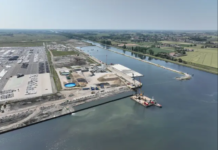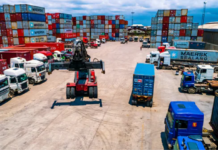Two of this nation’s highest-ranking port executives want continued government support for maritime industry clean air efforts and infrastructure development. They made that pitch this week in Oakland to an audience of 100 at the Pacific Transportation Association.
Port of Long Beach Executive Director Mario Cordero and Oakland counterpart Chris Lytle called for government aid and policy direction. Both are needed, they said, for the industry to digest global trade growth while further curbing freight transport diesel emissions.
“In California, we have the cleanest ports in the world,” said Mr. Lytle, who was Long Beach’s Executive Director before coming to Oakland. “But we could use help if we’re going to do more.”
Added Mr. Cordero, former Chairman of the Federal Maritime Commission, “we’ll be as successful as government support allows us to be.”
The pair spoke at a panel discussion for trade and transportation executives in the Port of Oakland’s Jack London Square. Their comments were timely. Both ports have spent much of the decade improving infrastructure to handle bigger ships and greater containerized cargo volume. They’ve also developed new guidelines to more aggressively curb diesel emissions.
Both port directors expressed gratitude for government grants supporting current clean air programs. Long Beach said it has reduced diesel particulate emissions 88 percent in the past decade. Oakland has reported a 76 percent reduction. More aid is needed to advance the clean air effort, Mr. Lytle said.
The executive directors said policy guidance in Washington, D.C., would help, too. Mr. Lytle called for nationwide clean air regulations to bring ports elsewhere up to California standards. Mr. Cordero said the U.S. needs a national freight policy to make port infrastructure a government priority.
Roads, bridges and rail networks must be upgraded to keep international supply chains humming, Mr. Cordero said. Mr. Lytle agreed, pointing to the example of Seventh Street in the Port of Oakland. Freight rails and trucks intersect at the major Port thoroughfare, he said. The Alameda County Transportation Commission is spearheading a $500 million effort to separate them. The project would include tunnels, overpasses and new traffic-control technology. When it’s completed, a freight-transport bottleneck will disappear, Mr. Lytle said.
“We can’t afford to do this ourselves,” Mr. Lytle said. “We rely on government to help and in this case, they’ve really stepped up.”





